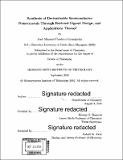| dc.contributor.advisor | Moungi G. Bawendi. | en_US |
| dc.contributor.author | Cordero Hernández, José Manuel | en_US |
| dc.contributor.other | Massachusetts Institute of Technology. Department of Chemistry. | en_US |
| dc.date.accessioned | 2017-03-20T19:39:46Z | |
| dc.date.available | 2017-03-20T19:39:46Z | |
| dc.date.copyright | 2016 | en_US |
| dc.date.issued | 2016 | en_US |
| dc.identifier.uri | http://hdl.handle.net/1721.1/107554 | |
| dc.description | Thesis: Ph. D., Massachusetts Institute of Technology, Department of Chemistry, 2016. | en_US |
| dc.description | Cataloged from PDF version of thesis. | en_US |
| dc.description | Includes bibliographical references (pages 135-145). | en_US |
| dc.description.abstract | Over the last decade, the synthesis methods of colloidal nanocrystals have advanced at an astonishing rate, producing particles that are chemically stable, monodisperse, and, in the case of semiconductor quantum dots (QDs), immensely bright. Inorganic nanocrystals linked to functional organic or biological molecules have recently emerged as a new class of nanomaterials for generating highly efficient devices, and sensing agents for a broad range of advanced applications. A key step in the synthesis of these constructs involves transforming the chemistry of the surface from that generated by the nanocrystals synthesis conditions (high boiling-point and hydrophobic solvent environment) to one possessesing the appropriate functional groups for derivatization and that is compatible with the intended final application. Here, we describe the synthesis of a series of organic ligands that modify the surface in that manner. The first ligand exhibits a norbornene functional group and binds strongly to the surface of colloidal nanocrystallites during particle synthesis, eliminating the need for ligand exchange and enabling large-scale production of high quality derivatizable nanomaterials. This ligand is compatible with state-of-the-art synthesis methods of a large variety of semiconductor nanocrystallites, including PbS, CdSe/CdS, and InAs/CdSe/CdS core/shell nanoparticles. Applications that make use of the norbornene click-chemistry functionality will be presented, along with efforts to preserve the high quantum yield and colloidal stability in water. We also introduce a bidentate carboxylate-based ligand as part of an effort to enhance the quality of QDs through the chelate effect. This ligands enhances the PLQY at high temperature, as a result of surface-related trap state passivation. Finally, we describe the synthesis of a new functional group for generating derivatizable-QDs that can be easily copolymerized with the polyimidazole ligand (PIL), and that is reactive with tetrazine and, upon thermal activation, with thiols to form stable bioconjugates. | en_US |
| dc.description.statementofresponsibility | by José Manuel Cordero Hernández. | en_US |
| dc.format.extent | 145 pages | en_US |
| dc.language.iso | eng | en_US |
| dc.publisher | Massachusetts Institute of Technology | en_US |
| dc.rights | MIT theses are protected by copyright. They may be viewed, downloaded, or printed from this source but further reproduction or distribution in any format is prohibited without written permission. | en_US |
| dc.rights.uri | http://dspace.mit.edu/handle/1721.1/7582 | en_US |
| dc.subject | Chemistry. | en_US |
| dc.title | Synthesis of derivatizable semiconductor nanocrystals through rational ligand design, and applications thereof | en_US |
| dc.type | Thesis | en_US |
| dc.description.degree | Ph. D. | en_US |
| dc.contributor.department | Massachusetts Institute of Technology. Department of Chemistry | |
| dc.identifier.oclc | 974639752 | en_US |
